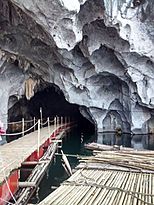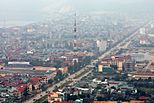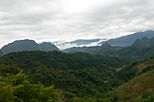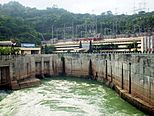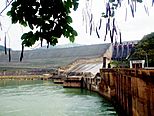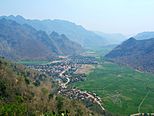Hòa Bình province facts for kids
Quick facts for kids
Hòa Bình province
Tỉnh Hòa Bình
|
|
|---|---|
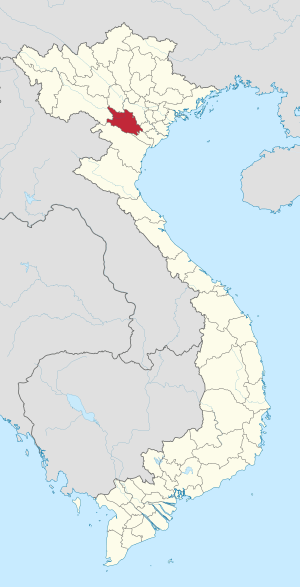
Location of Hòa Bình within Vietnam
|
|
| Country | |
| Region | Northwest |
| Capital | Hòa Bình |
| Subdivision | 1 city and 9 districts |
| Government | |
| • Type | Province |
| • Body | Hòa Bình Provincial People's Council |
| Area | |
| • Province | 4,600.3 km2 (1,776.2 sq mi) |
| Population
(2021)
|
|
| • Province | 869,050 |
| • Density | 188.9116/km2 (489.279/sq mi) |
| • Urban | 142,131 |
| Ethnic groups | |
| • Mường | 64.28% |
| • Vietnamese | 25.69% |
| • Thái | 4.03% |
| • Tày | 3.02% |
| • Dao | 2.02% |
| • Others | 0.96% |
| Time zone | UTC+7 (ICT) |
| Area codes | 218 |
| ISO 3166 code | VN-14 |
Hòa Bình (pronounced "Hwah Bin") is a beautiful, mountainous province in Vietnam. It's located in the country's Northwest region. This province shares its borders with several other provinces and the capital city, Hanoi.
Hòa Bình covers about 4,590 square kilometers (1,772 square miles). In 2019, around 854,131 people lived there. The province's economy is growing, with its income per person estimated at $2,625 in 2020.
Contents
History of Hòa Bình Province
Hòa Bình province was first created on June 22, 1886. It was originally called "Mường Province." This new province was formed by taking parts from several nearby areas. Its name, "Hòa Bình," comes from Vietnamese words meaning "peace."
The province's main town was first in Chợ Bờ. Because of this, it was sometimes called "Chợ Bờ Province." Later, the main town moved to Phương Lâm. In April 1888, the French rulers renamed it "Phương Lâm province."
On March 18, 1891, the name officially changed to Hòa Bình province. It was divided into six main areas called districts. Over the years, new districts were formed from parts of the older ones. For example, Tân Lạc District was created in 1957. Kim Bôi District was formed in 1959. Yên Thủy District was created in 1964. Cao Phong District was formed in 2001. In 2019, Kỳ Sơn District became part of Hòa Bình city.
People of Hòa Bình
Hòa Bình province is home to many different groups of people. In 2019, the province had a population of 854,131. Most people live in the countryside, while a smaller number live in cities.
Vietnam officially recognizes over 40 different ethnic groups. Hòa Bình province has many of these groups. Each group has its own language, traditions, and unique culture. The largest groups living in Hòa Bình are:
- Mường people: They make up about 64% of the population.
- Vietnamese people: They are about 25% of the population.
- Thái people: They make up about 4% of the population.
- Tày people: They are about 3% of the population.
- Dao people: They make up about 2% of the population.
Other smaller groups make up the rest of the population. This mix of cultures makes Hòa Bình a very interesting place!
Fun Places to Visit in Hòa Bình
Hòa Bình is famous for its rich culture and beautiful nature. Many people believe it's a very old cultural center in Vietnam. There are five main ethnic groups living here: Muong, Thai, Mong, Tay, and Dao. The province also has many historical sites and natural spots to explore.
Here are some popular places to visit:
- Mai Châu: This is a town known for its traditional ethnic groups. You can see beautiful rice fields and green mountains here. It's about 140-150 km from Hanoi, and you can get there by motorbike, bus, or car.
- Thung Nai: People call this place the 'Ha Long Bay on land'. It's in Cao Phong District. Thung Nai has stunning mountains, hills, and a large lake. Cao Phong is also known for its tasty orange farms.
- Kim Bôi Hot Spring: This is a must-see spot in Kim Bôi District. It's only 30 km from Hòa Bình city. You can enjoy natural mineral water here, which stays at a warm 36 degrees Celsius. It's great for bathing and is thought to be good for your health.
- Hòa Bình Dam: This huge dam is on the Da River. When it was built in 1979, it was the biggest hydropower plant in Southeast Asia. It's an important historical site in Vietnam.
How Hòa Bình is Organized
Hòa Bình province is divided into 10 main areas. These include one city and nine districts. These larger areas are then split into 151 smaller sections, like towns and communes.
| Administrative divisions of Hòa Bình | ||||||||||||||||||||||||||||||||||||||||||||
|---|---|---|---|---|---|---|---|---|---|---|---|---|---|---|---|---|---|---|---|---|---|---|---|---|---|---|---|---|---|---|---|---|---|---|---|---|---|---|---|---|---|---|---|---|
|
|
|||||||||||||||||||||||||||||||||||||||||||
See also
 In Spanish: Provincia de Hòa Bình para niños
In Spanish: Provincia de Hòa Bình para niños



